Unlock the secrets to a thriving, vibrant Pothos plant with this definitive guide. Whether you’re a first-time plant parent or a seasoned enthusiast, this article is your all-in-one resource for mastering every aspect of Pothos care, from identifying stunning varieties to expertly propagating new growth and solving common problems. We’ve meticulously compiled expert-backed advice, interactive tools, and advanced tips to ensure your Pothos plant flourishes, transforming your home into a lush, green sanctuary. Get ready to cultivate the healthiest, most beautiful Pothos you’ve ever imagined.
TABLE OF CONTENTS
Why This Plant is a Must-Have
The Pothos plant (Epipremnum aureum), often affectionately known by common names such as Devil’s Ivy, Money Plant, or Hunter’s Robe, is a tropical vine native to the Solomon Islands. Renowned for its heart-shaped leaves and vigorous trailing habit, it has earned its place as one of the most popular houseplants worldwide. Its incredible adaptability and striking foliage make it an undeniable must-have for any plant collection.
Its popularity stems from several key factors. Pothos is incredibly forgiving, making it an ideal choice for beginners. It tolerates a range of light conditions, bounces back quickly from minor neglect, and requires minimal specialized care. Beyond its ease, the Pothos adds immense aesthetic appeal, with its cascading vines capable of transforming any space, from a bookshelf accent to a stunning vertical garden. Furthermore, it’s celebrated for its air-purifying qualities, actively filtering common indoor toxins.
Pothos Myth vs. Fact
Myth: Pothos is indestructible and needs no care. Fact: While resilient, Pothos thrives with consistent, appropriate care, leading to healthier growth and more vibrant variegation.
Myth: All Pothos plants look the same. Fact: There’s a stunning array of Pothos varieties, each boasting unique colors, patterns, and leaf shapes, as we’ll explore later.
Myth: Pothos can’t survive in low light. Fact: Pothos tolerates low light, but its growth will be slower, and variegation may fade. Bright, indirect light is ideal.
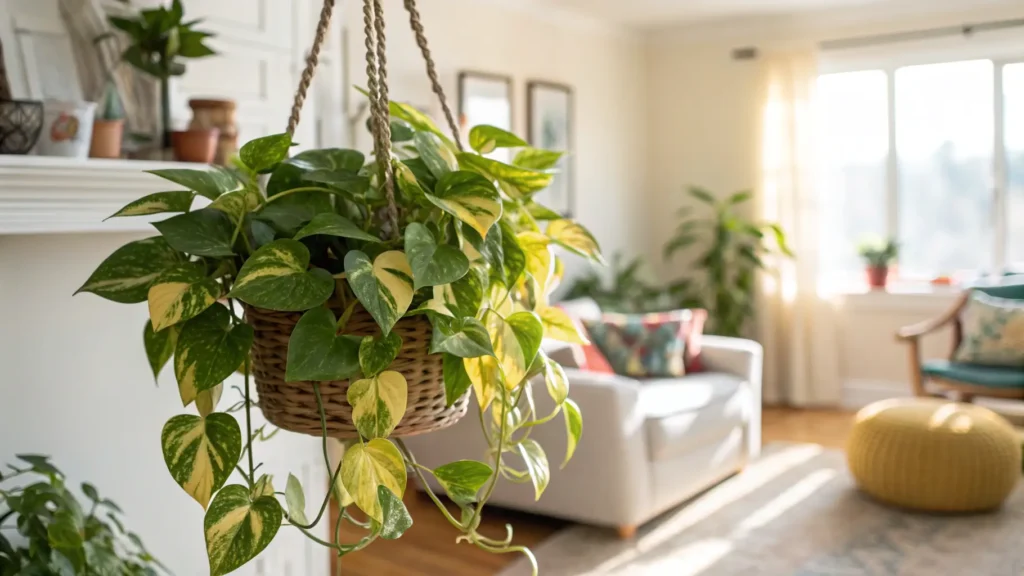
Pothos Care Essentials: Nurturing Your Plant to Thrive
Mastering Pothos care is simpler than you might think. With the right fundamental practices, your plant will not only survive but truly thrive. This section covers all the vital aspects to ensure your Pothos remains lush and healthy.
Light Requirements
Pothos plants are incredibly adaptable when it comes to light, making them suitable for various home environments. Optimal growth occurs in bright, indirect light, which encourages vibrant variegation and robust foliage. Avoid direct, harsh sunlight, which can scorch the leaves, especially variegated varieties. Conversely, insufficient light will lead to leggy growth and a loss of variegation.
Signs of too much light: Scorched, bleached, or yellowing leaves with brown patches. Signs of too little light: Slow growth, small leaves, faded variegation, and long, sparse stems.
Pro Tip: Rotate your Pothos plant periodically to ensure all sides receive adequate light, promoting even growth and preventing it from becoming lopsided.
Watering Your Pothos
Overwatering is the most common mistake Pothos owners make, leading to root rot. The key to successful watering is the “Thorough & Dry” method. Water your Pothos thoroughly until water drains from the bottom of the pot, then allow the top 1-2 inches of soil to dry out completely before watering again.
To check soil moisture, simply stick your finger into the soil. If it feels dry, it’s time to water. If it still feels moist, wait a few more days. The frequency will vary depending on light, temperature, and pot size.
Common Overwatering Symptoms: Yellowing leaves, mushy stems, wilting (despite moist soil), and a foul odor from the soil. Common Underwatering Symptoms: Drooping leaves, crispy edges, slow growth, and dry, hardened soil.
Pro Tip: Use a moisture meter for an accurate reading, especially for larger pots, to avoid guesswork.
Soil & Potting
A well-draining potting mix is crucial for Pothos health. A standard indoor potting mix amended with perlite or orchid bark (about a 2:1:1 ratio of potting mix:perlite:bark) provides the ideal balance of drainage and moisture retention. This prevents soggy soil, which can lead to root rot.
When choosing a pot, opt for one with drainage holes. Terra cotta pots can help wick away excess moisture, while plastic pots retain it longer. Repot your Pothos when it becomes root-bound, typically every 1-2 years. Choose a pot only one size larger than the current one to avoid excessive soil moisture.
Step-by-step repotting guidance:
- Gently remove the Pothos from its old pot.
- Loosen any circling roots.
- Add a layer of fresh potting mix to the new pot.
- Center the plant, ensuring the top of the root ball is level with the rim.
- Fill with more potting mix, gently tamping it down.
- Water thoroughly.
Pro Tip: Repotting during spring or early summer, when the plant is actively growing, minimizes stress and promotes quicker recovery.
Temperature & Humidity
Pothos plants thrive in average household temperatures, ideally between 65-80°F (18-27°C). They are sensitive to extreme cold and sudden temperature fluctuations, which can cause stress and leaf damage. Avoid placing your Pothos near drafty windows, air conditioning vents, or heating units.
While Pothos tolerates average indoor humidity, it flourishes with higher levels (50-70%). Increased humidity can promote larger leaves and more vigorous growth.
Simple ways to increase humidity:
- Group plants together.
- Place the pot on a pebble tray with water (ensure the pot isn’t sitting directly in water).
- Use a room humidifier, especially in dry environments.
Pro Tip: Misting can provide a temporary humidity boost but is less effective than other methods for long-term humidity. Consider it an aesthetic treat rather than a primary solution.
Fertilizing
Pothos is not a heavy feeder, but regular fertilization during its growing season (spring and summer) can encourage lush growth. Use a balanced, all-purpose liquid houseplant fertilizer diluted to half strength, typically once a month. Reduce or stop fertilizing during fall and winter when growth naturally slows down.
Common nutrient deficiencies and how to correct them:
- Yellowing lower leaves: Often a sign of nitrogen deficiency. A balanced fertilizer will help.
- Stunted growth or dull leaves: Could indicate a general lack of nutrients. Increase fertilization frequency (still diluted).
- Brown leaf edges or spots: Can be a sign of over-fertilization (salt buildup). Flush the soil with water and reduce fertilizer strength/frequency.
Pro Tip: Always water your Pothos before fertilizing to prevent root burn.
Are Pothos Plants the Perfect Beginner Plant? 4 Varieties with Care Tips!
Pothos Varieties & Identification: A Complete Visual Guide
The world of Pothos varieties is incredibly diverse and captivating, offering a spectrum of colors, patterns, and leaf shapes. This section is designed to help you identify your Pothos plant and appreciate the unique beauty of each type.
Understanding Pothos Variegation
Variegation refers to the different colored zones in the leaves of a plant. In Pothos, this is due to variations in chlorophyll production. Less green (chlorophyll) means more white, yellow, or silver areas. The amount of light a variegated Pothos receives directly impacts the vibrancy and extent of its variegation. More light generally leads to more pronounced patterns, while low light can cause variegation to fade, resulting in greener leaves.
Common Pothos Types
Golden Pothos
- Characteristics: The classic Pothos, featuring dark green, heart-shaped leaves splashed with streaks of golden yellow. The variegation intensifies with brighter light.
- Specific Care Nuances: Tolerant of lower light but thrives in bright, indirect light for best variegation.
- Growth Habits: Fast-growing, trailing vine; can grow quite long.
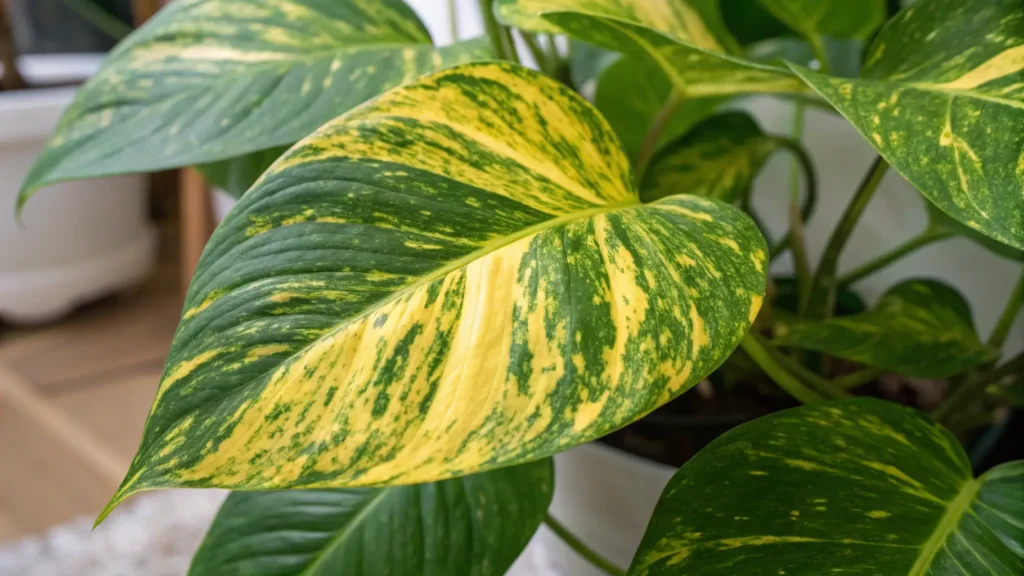
Marble Queen Pothos
- Characteristics: Characterized by heavy white or cream variegation on dark green leaves, giving it a distinct marbled appearance. More white means less chlorophyll, making it a slower grower.
- Specific Care Nuances: Requires brighter, indirect light than Golden Pos for variegation to remain prominent. Avoid direct sun.
- Growth Habits: Moderate growth rate, can produce long, lush vines.

Neon Pothos
- Characteristics: Features striking, uniform chartreuse to bright lime-green leaves with little to no variegation. The leaves can be quite luminous.
- Specific Care Nuances: Its solid color means it’s slightly more tolerant of lower light, but bright, indirect light will enhance its vibrant color.
- Growth Habits: Moderate to fast-growing, with a bushy, trailing habit.
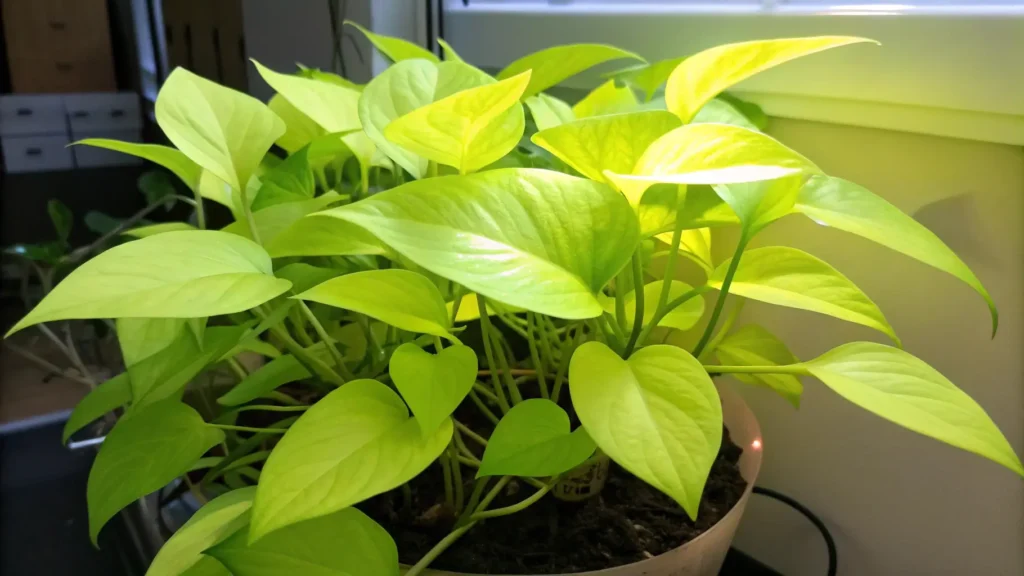
N’Joy Pothos
- Characteristics: Distinctive for its clearly defined, stark white variegation on dark green leaves. The white patches are often irregular and concentrated on the leaf margins.
- Specific Care Nuances: Needs consistent bright, indirect light to maintain its crisp variegation.
- Growth Habits: Slower growing and more compact than Golden or Neon, making it ideal for smaller spaces.
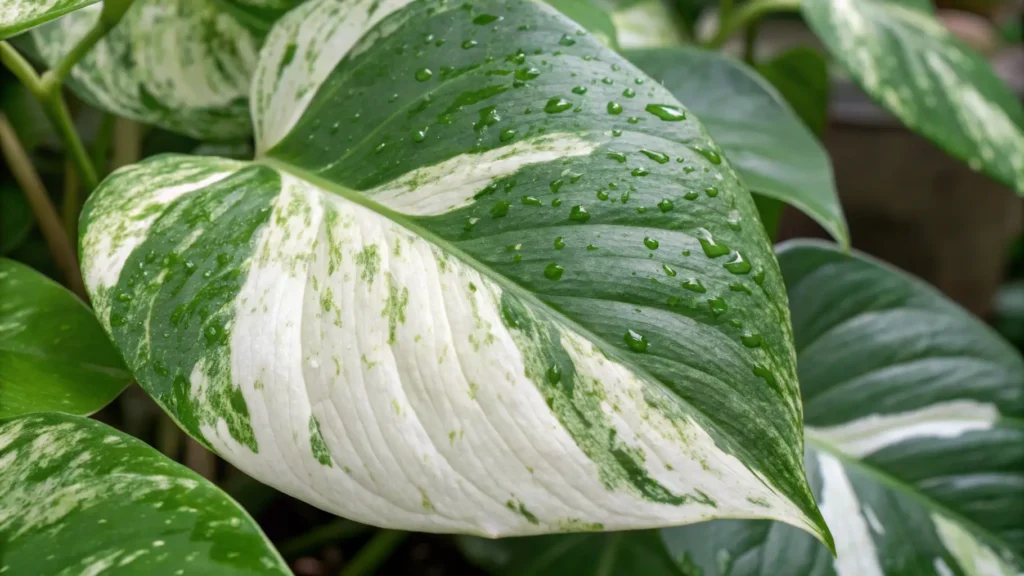
Pearls and Jade Pothos
- Characteristics: Similar to N’Joy but with more variegated colors. It displays patches of white, silver-gray, and sometimes green on the dark green leaves. The variegation typically appears closer to the center of the leaf, often splattered.
- Specific Care Nuances: Prefers bright, indirect light to maintain its complex variegation.
- Growth Habits: Compact and slower growing, similar to N’Joy.

Manjula Pothos
- Characteristics: Considered a highly sought-after variety, Manjula features broad, wavy-edged leaves with a mix of creamy white, silver, and light green variegation. The white patches often extend into the green, blurring the lines.
- Specific Care Nuances: Requires ample bright, indirect light to fully express its stunning variegation.
- Growth Habits: Grows more slowly than common varieties, producing a dense, full plant.
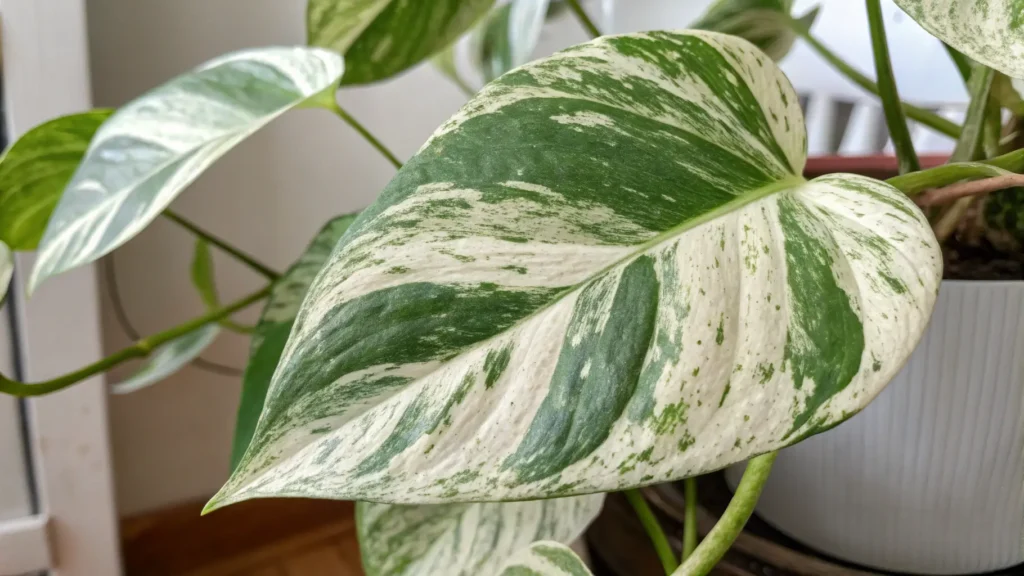
Cebu Blue Pothos
- Characteristics: Unique for its elongated, somewhat pointed leaves with a silvery-blue-green hue. Unlike other varieties, it’s typically non-variegated, and its leaves can develop fenestrations (splits) as it matures, mimicking a Monstera.
- Specific Care Nuances: Tolerates lower light but bright, indirect light encourages its characteristic blue tones and potential fenestrations.
- Growth Habits: A moderate to fast-growing climber that loves to trail or climb.

Global Green Pothos
- Characteristics: Features dark green leaves with lighter, brighter green variegation that appears as distinct patches, often along the midrib. The two shades of green are clearly demarcated.
- Specific Care Nuances: Adaptable, but bright, indirect light ensures the contrast between the green shades is pronounced.
- Growth Habits: Compact and relatively slow-growing, creating a dense plant.
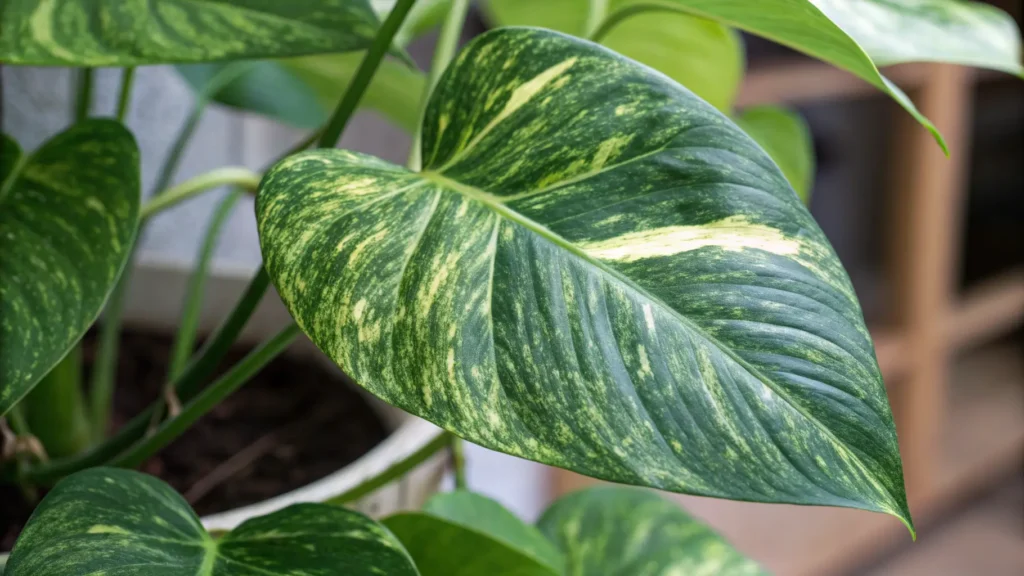
Jessenia Pothos
- Characteristics: Similar to Marble Queen but with olive-green or lime-green variegation on a darker green base, creating a softer, more subtle marbled effect.
- Specific Care Nuances: Prefers bright, indirect light for optimal variegation display.
- Growth Habits: Moderate growth rate with a lovely trailing habit.
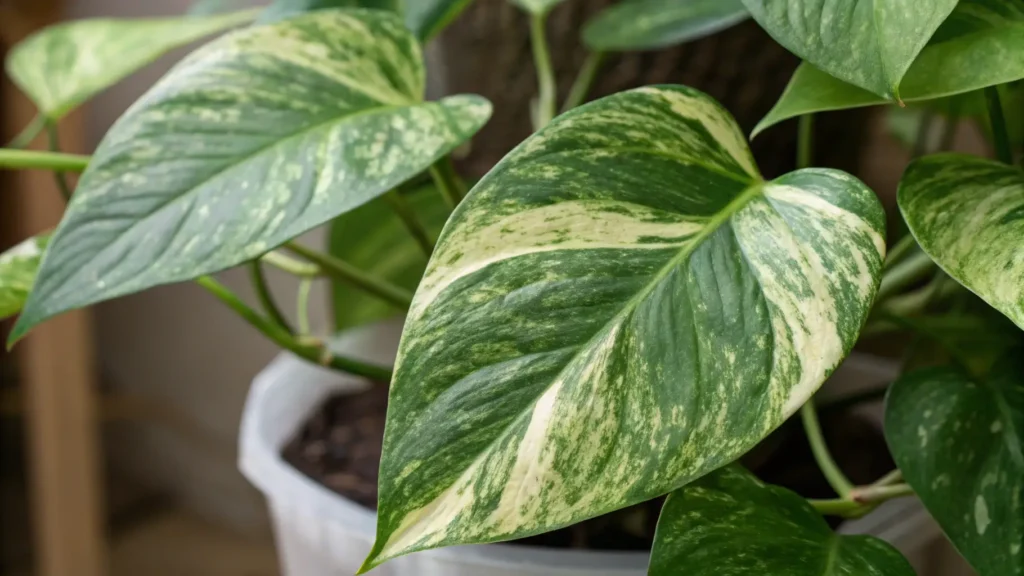
Rare & Emerging Varieties
Beyond the common types, the world of Pothos continues to expand with rarer and emerging varieties like ‘Shangri-La’ (crinkled, almost ruffled leaves) or ‘Happy Leaf’. These are often sought after by collectors for their unique aesthetics and limited availability. Their care often mirrors that of their common cousins, with a keen eye on light levels for variegated forms.
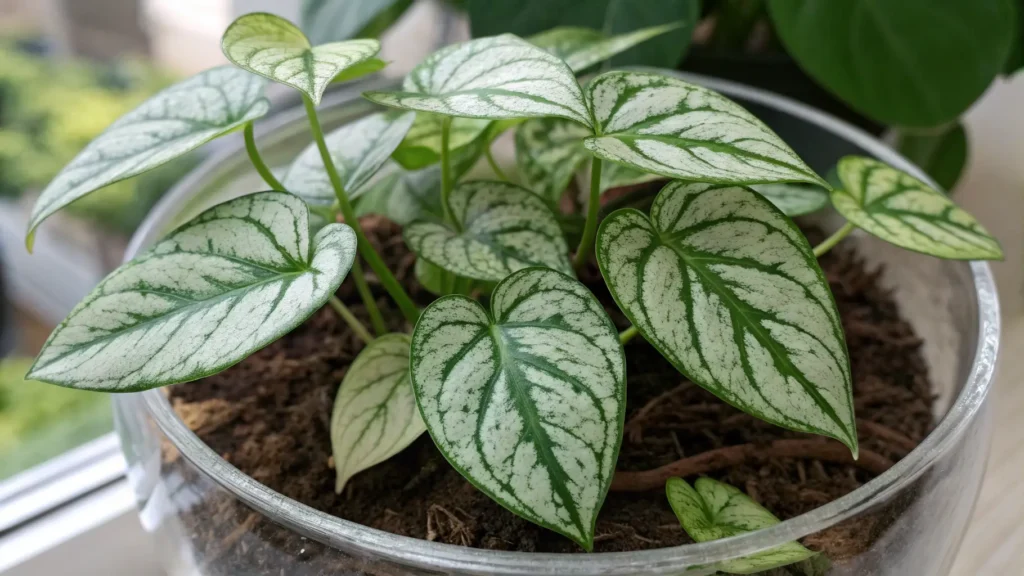
How to Identify Your Pothos
Identifying your Pothos often comes down to observing the color, pattern, and distribution of its variegation, as well as its overall leaf shape and growth habit.
- Coloration: Is it yellow, white, silver, or blue-green?
- Pattern: Are the colors splashed, marbled, speckled, or distinct patches?
- Distribution: Is the variegation concentrated on the edges, centers, or evenly spread?
- Leaf Shape: Are the leaves classic heart-shaped, elongated, or wavy-edged?
Propagating Pothos: Expand Your Green Collection with Ease
Propagating Pothos is one of the most rewarding aspects of owning this plant. It’s incredibly easy to do and allows you to expand your collection, share with friends, or simply create a bushier mother plant.
Why Propagate Pothos?
- Create new plants: Easily multiply your favorite Pothos varieties.
- Encourage bushiness: Pruning for propagation often stimulates new growth on the mother plant.
- Share with friends: Pothos cuttings make excellent gifts.
- Revitalize leggy plants: Take cuttings from long, sparse stems to start fresh, fuller plants.
Best Time for Propagation
The ideal time for Pothos propagation is during its active growing season: spring and summer. During these months, the plant has more energy and resources to put into root development, leading to higher success rates.
Step-by-Step Water Propagation
Water propagation is arguably the easiest and most popular method for Pothos.
- Take Cuttings: Select a healthy stem with at least 2-3 leaves and a node (the small bump where a leaf emerges or once emerged). Make a clean cut just below a node using sharp, sterilized scissors or pruners.
- Optimal Cutting Size: Cuttings typically range from 4-6 inches long. Ensure each cutting has at least one node, as this is where roots will emerge. Remove any leaves that would be submerged in water to prevent rot.
- Using Rooting Hormone (Optional): Dip the cut end of the stem in rooting hormone powder or gel. While not strictly necessary for Pothos, it can sometimes speed up root development.
- Maintaining Water Quality: Place the cuttings in a clear jar or vase filled with room-temperature water. Change the water every few days to keep it fresh and prevent bacterial growth.
- Placement: Position the jar in a spot with bright, indirect light.
- Root Development: Roots typically start to appear within 1-3 weeks. Wait until the roots are at least 1-2 inches long before transplanting.
- Transplanting to Soil: Once roots are well-established, carefully plant the cuttings in a small pot with well-draining potting mix. Water thoroughly.
Step-by-Step Soil Propagation
Direct soil propagation can also be successful, especially for creating a fuller plant directly.
- Take Cuttings: Follow the same cutting procedure as for water propagation.
- Direct Planting of Cuttings: Plant the cut end of the stem (with optional rooting hormone) directly into moist, well-draining potting mix. Ensure at least one node is buried.
- Creating a Humid Environment: To aid rooting, cover the pot with a clear plastic bag or dome to create a mini-greenhouse effect, maintaining high humidity. Prop the bag up so it doesn’t touch the leaves.
- Initial Care: Place in bright, indirect light. Keep the soil consistently moist but not soggy. Roots will typically form within 3-6 weeks.
Troubleshooting Common Propagation Issues
- No roots: Ensure the cutting has at least one node, provide adequate light, and be patient. Rooting hormone can sometimes help.
- Stem rot: This often occurs if leaves are submerged in water or if the water isn’t changed regularly. Remove rotting parts, use fresh water, and ensure no leaves are in the water.
- Leaf yellowing: A few yellowing leaves during propagation are normal as the plant redirects energy to root production. If many leaves yellow, check water quality and light.
Troubleshooting Common Pothos Problems & Solutions
Even the most resilient Pothos can encounter issues. Knowing how to diagnose and address common problems is key to keeping your plant healthy.
Yellow Leaves
Yellowing leaves are one of the most frequent signs of Pothos distress.
- Causes:
- Overwatering: The most common cause, leading to root rot.
- Underwatering: Can also cause yellowing, often accompanied by drooping.
- Nutrient Deficiency: Particularly nitrogen.
- Natural Aging: Older leaves at the bottom of the plant naturally yellow and drop.
- Solutions:
- Overwatering: Check soil moisture, allow soil to dry out more between waterings, ensure good drainage. Repot if root rot is severe.
- Underwatering: Water thoroughly, adjust watering schedule.
- Nutrient Deficiency: Fertilize during the growing season with a balanced houseplant fertilizer.
- Natural Aging: Remove yellowed leaves; this is normal.
Brown/Crispy Leaves
Dry, crispy leaves usually indicate a lack of moisture.
- Causes:
- Underwatering: Plant isn’t getting enough water.
- Low Humidity: Especially in dry indoor environments or during winter.
- Sunburn: Direct, harsh sunlight can scorch leaves.
- Remedies:
- Underwatering: Water immediately and deeply. Adjust your watering routine.
- Low Humidity: Increase humidity around the plant using methods mentioned earlier (pebble tray, humidifier).
- Sunburn: Move your Pothos to a location with bright, indirect light. Trim off severely damaged leaves.
Drooping Pothos
A drooping Pothos signals that something is seriously off with its water balance.
- Causes:
- Underwatering: Leaves become limp and lifeless.
- Root Rot (from overwatering): Roots are unable to absorb water, even if the soil is wet.
- Temperature Shock: Sudden drastic changes in temperature.
- How to Revive:
- Underwatering: Water thoroughly. The plant should perk up within a few hours.
- Root Rot: Inspect roots. Trim off mushy, black roots. Repot in fresh, well-draining soil and a clean pot. Adjust watering habits.
- Temperature Shock: Move the plant to a stable environment.
Slow Growth or Leggy Stems
If your Pothos isn’t growing vigorously or develops long, sparse stems.
- Causes:
- Insufficient Light: Not enough light for photosynthesis.
- Nutrient Deficiency: Lack of essential nutrients to support new growth.
- Lack of Pruning: Regular pruning encourages bushier growth.
- Growth-Boosting Tips:
- Increase Light: Move to a brighter, indirect light location.
- Fertilize: Provide a balanced fertilizer during the growing season.
- Prune Regularly: Trim back long, leggy stems. This stimulates new growth from the nodes, leading to a fuller plant.
Common Pests
While relatively pest-resistant, Pothos can occasionally suffer from infestations.
- Identification:
- Spider Mites: Tiny red or brown mites, fine webbing on leaves, stippling.
- Mealybugs: Small, white, cottony masses in leaf axils and on stems.
- Scale: Small, brown, immobile bumps on stems and undersides of leaves.
- Fungus Gnats: Small, dark flies hovering around the soil surface, especially in moist soil.
- Treatments:
- Natural: For minor infestations, wipe leaves with a damp cloth or cotton swab dipped in rubbing alcohol. Neem oil spray can be very effective.
- Chemical: Insecticidal soaps or targeted pesticides for severe cases.
- Prevention: Inspect plants regularly, isolate new plants, maintain good air circulation.
Fungal Diseases
Fungal issues are less common but can occur with overwatering or poor air circulation.
- Overview of common fungal issues (e.g., powdery mildew): Appears as white, powdery spots on leaves. Root rot (discussed under yellow leaves) is also a fungal problem.
- Prevention: Avoid overwatering, ensure good air circulation, prune crowded foliage, and use sterilized tools. Treat with fungicidal sprays if necessary.
Advanced Pothos Care & Creative Display Ideas
Beyond basic care, there are many ways to optimize your Pothos plant’s growth and integrate it beautifully into your home.
Pruning for Bushiness & Shape
Regular pruning is essential for maintaining your Pothos’s health and aesthetic.
- Advanced Pruning Techniques:
- Pinch Back: Regularly pinch off the growing tips of vines to encourage side branching, leading to a bushier plant.
- Strategic Cutting: For leggy stems, cut them back to just above a leaf node. New growth will emerge from that node, and you can propagate the cuttings.
- Shaping: Guide the plant’s growth by selectively pruning vines to maintain a desired shape or length.
Training & Support
Pothos is a natural climber in its native habitat. Providing support can encourage larger leaves and a more mature appearance.
- Encouraging Climbing:
- Moss Poles: Ideal for vertical growth. Secure vines to the pole with plant ties as they grow. The aerial roots will eventually grip the moss.
- Trellises: Small trellises can be placed in pots for elegant vertical displays.
- Wall Clips: Adhesive clips can be used to train vines directly onto walls, creating stunning green patterns.
- Trailing: Simply allow your Pothos to cascade from shelves, hanging baskets, or pot stands for a classic look.
Pothos vs. Philodendron: The Ultimate Comparison
Many new plant enthusiasts confuse Pothos with Heartleaf Philodendron due to their similar appearance. Here’s how to tell them apart:
| Feature | Pothos (Epipremnum aureum) | Heartleaf Philodendron (Philodendron hederaceum) |
|---|---|---|
| Leaves | Thicker, waxy, often with bumps at the base of the petiole. | Thinner, softer, typically smooth at the base of the petiole. |
| New Leaves | Emerge rolled up but directly from the stem. | Emerge encased in a papery cataphyll (sheath) that later dries and falls off. |
| Growth Habit | More robust and vigorous, often with larger leaves. | Tend to have smaller leaves and a more delicate appearance. |
| Aerial Roots | More prominent, thicker, and knotty. | Finer and less pronounced. |
| Texture | Slightly rougher feel. | Smoother, glossier feel. |
Creative Display Ideas
Unleash your creativity with unique ways to display your Pothos.
- Hanging Baskets: A classic choice, allowing vines to cascade freely.
- Vertical Gardens/Wall Mounts: Train Pothos up or across walls for a living art piece.
- Terrariums: Smaller Pothos cuttings or compact varieties can thrive in high-humidity terrariums.
- Shelf Arrangements: Let vines spill over the edges of bookshelves or cabinets.
- Mixed Planters: Combine Pothos with other houseplants that have similar care requirements for diverse textures and colors.
Pothos FAQs
Here are answers to some of the most common questions about Pothos plants.
Is Pothos toxic to pets or humans? Yes, Pothos contains calcium oxalates, which can cause irritation to the mouth, throat, and digestive tract if ingested. Keep out of reach of pets and small children.
Can Pothos grow without soil (e.g., hydroponically)? Absolutely! Pothos can thrive indefinitely in water, provided the water is regularly changed and fertilized with a liquid hydroponic nutrient solution.
How fast do Pothos plants typically grow? With optimal conditions (bright, indirect light, consistent watering, and occasional fertilization), Pothos can grow quite rapidly, often putting out several inches of new growth per month during the spring and summer.
What are the documented air purification benefits of Pothos? Studies, most notably by NASA, have shown that Pothos can help remove common indoor air toxins like formaldehyde, benzene, and carbon monoxide. While not a complete air purification system, it contributes positively to indoor air quality.
Can Pothos tolerate low light conditions? Pothos is remarkably tolerant of low light, which makes it a popular choice for darker rooms. However, growth will be slower, and variegated varieties may lose some of their distinctive patterns, appearing greener over time.
Conclusion
The Pothos plant truly stands out as an exceptional houseplant, celebrated for its striking beauty, incredible resilience, and surprising versatility. From its diverse array of captivating varieties to its straightforward Pothos care requirements, there’s a reason why this plant continues to be a favorite among plant enthusiasts globally. We’ve journeyed through every critical aspect, providing you with an exhaustive guide, interactive insights, and solutions for any challenge you might encounter.
By applying the detailed tips on lighting, watering, soil, and advanced techniques like pruning and propagation, you are now equipped to not only maintain but truly elevate your Pothos plant’s health and aesthetic appeal. Embrace the joy of nurturing your green companion, explore its many forms, and confidently troubleshoot any issue. Your thriving Pothos is just a few intentional steps away. Start implementing these strategies today and watch your plant flourish!
